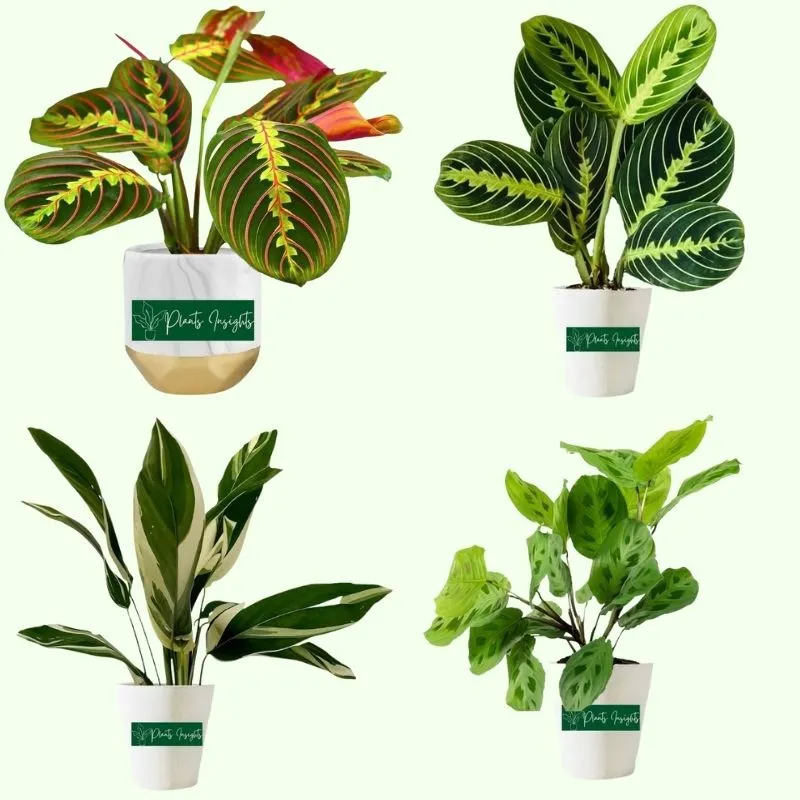The Maranta genus plants are commonly called Prayer plants because of the foliage movement with respect to light changes during day and night. Maranta plants are low-growing perennials hailing from the tropical rainforest of Brazil.
Prayer plants attract plant lovers with their adorable decorative leaves. The popular tricolor variety features deep green, velvety-textured glossy leaves with yellow veins running down the middle. Prayer plants are moderate growers and can reach up to one foot in height indoors. They can be kept indoors and outdoors throughout the year.
Prominent Family Members: Maranta Arundinacea, Maranta Kerchoveana, Maranta Leuconeura Lemon Lime, Maranta Leuconeura Silver Band
Essential Products:
How Do You Care for the Prayer Plant?
Marantas thrive in climates that resemble the tropical rainforest, which is hot and humid with moist soil and plenty of fertilizer. However, excess plant requirements like water and light impair plant growth; therefore, we have discussed all necessary requirements in detail to keep the Prayer Plants happy and thriving.
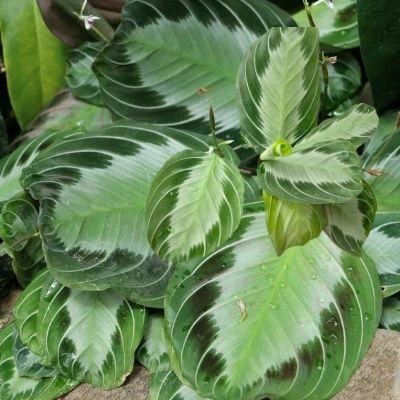
Beautiful foliage of Maranta Leuconeura

Light
Marantas usually thrive well in the areas with diffused indirect medium bright light. They are great indoor plants, and the best spaces to display them in your home are which do not receive direct sunlight. The Prayer plant flourishes even in complete shade. However, when exposed to intense natural sunlight, Prayer plants’ leaves may grow large brown spots and eventually fall off.
If your plant leaves fade and loses their bright color, immediately move them to a shady area. In winter, the plant is in the dormancy stage; make sure you provide plenty of bright light to sustain their growth.
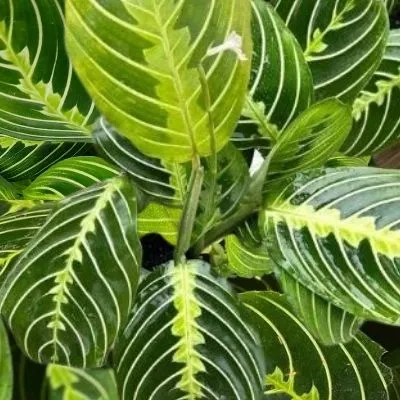
Tiny flower of Maranta Lemon Lime

Temperature and Humidity
Prayer plants flourish in the hot atmosphere indoors, with temperatures ranging from 60 to 80°F. Prolonged exposure to plants at low temperatures can harm the plants’ health; leaves may fall excessively, and the plant can die if remedial action is not taken.
Prayer plants love to grow in a minimum of 50% humidity but flourish extraordinarily if a 70% humidity level is around them. To maintain the required moisture in the surroundings, use a plant humidifier or gather all humidity-loving indoor plants together.
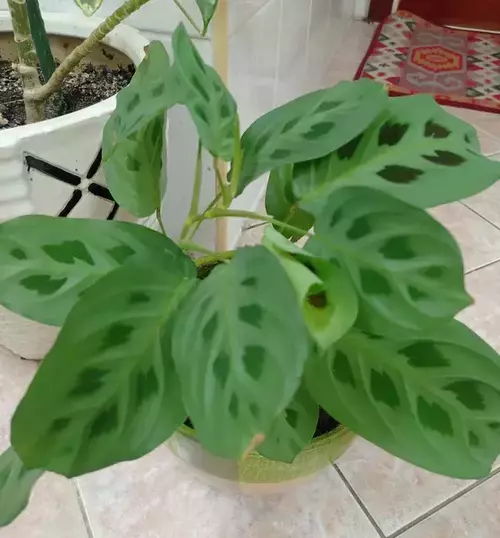
Prayer plant
Moreover, you can make a humidifier in the home for your plant. Please fill a deep tray with small-sized pebbles or rocks and place the pot on the rocks. Fill half of the tray with distilled water and ensure the pot’s base is above the water.
Furthermore, it is also possible to mist the leaves with water. To avoid fungal diseases, you shall not let the water drops sit directly on the leaves for a longer duration and wipe the foliage with a clean cloth.

How often should I water a Prayer plant?
Marantas are moisture-loving plants; therefore, please water your Prayer plant regularly during the growing season from early spring to late summer, and don’t let the soil dry completely.
We recommend watering the plant whenever the soil’s top two-inch layer is dry. You can check the soil dampness by putting a finger or using a moisture meter for accurate results.
Please ensure to avoid overwatering of the prayer plant as it will make potting soil soggy, and fungal diseases can attack the plant’s roots. Excessive yellowing of leaves is the prime symptom of overwatering.
Furthermore, please water your prayer plant with distilled water or filtered water. We recommend avoiding tap water because it contains chemicals that can harm Prayer plant growth.

Soil
Maranta thrive in all kinds of soils as long as it is well-draining. The ready-made soil mix is available in the market for Prayer plants; however, you can also make your own by mixing one portion of loamy soil, two parts of sphagnum peat moss, and one portion of fine perlite or sand.
Please do not forget to add gravel or rocks to the pot’s bottom so the water will not accumulate at the bottom of the pot. While selecting a pot for your Prayer Plant, please ensure the pot has an adequate drain hole.
Prayer plants or Maranta Leuconeura prefers slightly acidic soil and loves residing in soil with a PH level between 5.5 to 6.0.

Fertilization
Maranta plants require nutrient-rich moist soil to thrive. Please fertilize your prayer plant twice a month during the growing seasons of spring to summer. Do not fertilize the plant during the dormant period.
You shall use a liquid-based balanced houseplant fertilizer in liquid or slow-release form. Please always use less than recommended fertilizer strength, and water your plant before fertilizing it. Overfertilizing is not beneficial for plants’ health.
If the leaves begin to turn brown after fertilization, flush the potting soil by placing the pot under the tap for two mins and then let drain excess water from the pot.

Types of Prayer Plants
There are a variety of Prayer plants; however, the most well-known is the tricolor variety found in various gardening centers. Prayer plants and calatheas are so closely related that it’s common for these plants to get mislabeled. Within the Maranta Genus, the following handful of species are the most well-known:
M. Leuconeura Erythrophobia: This three-colored prayer plant, sometimes referred to as the Herringbone plant, is the most well-known species and has large red veins.
M. Leuconeura Kerchoveana: This type is sometimes referred to as Rabbit’s Tracks and has plain green leaves with 2 rows of dark streaks.
M. Leuconeura Massangeana features a darker background and silvery blotches along the midrib and the veins of white leaves.

Propagating Prayer Plants
Propagating Prayer-plants is an effortless way to expand your favourite Prayer plant collection. The advantage of bigger mother Prayer plants is they can make more than one baby plant.
The simplest method of propagation of Prayer plants is by root division. The roots division method is simply dividing the plant’s roots and then repotting them in moist soil. Here’s is how you can successfully propagate your favourite prayer plant:
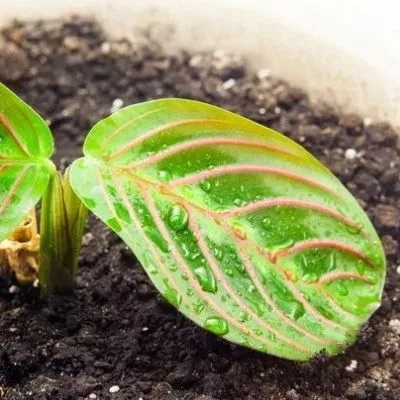
Baby prayer plnat

Maranta Plant’s Pests
Prayer plants’ common pests are Spider mites, Mealybugs, Aphids, and Fungal gnats. If you detect an infestation, like a white powdery substance appearing on leaves or webs on the stem and leaf joints, or discoloration or browning of the leaves. Treat the plant using insecticidal soap or rubbing Neem oil, an organic insecticide.

